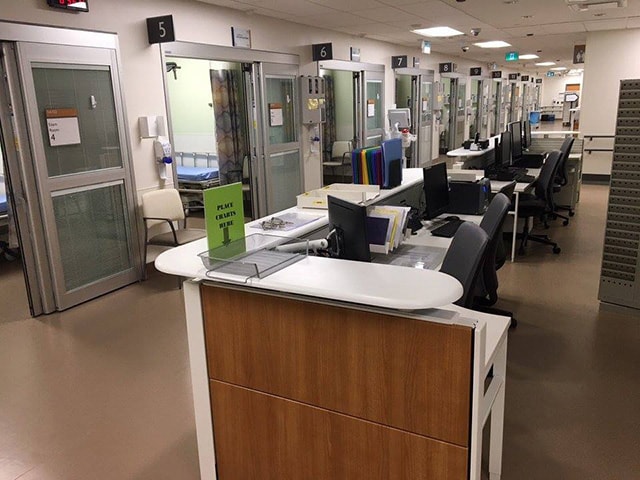Should Brampton Civic Follow This Hospital’s Model for Shorter Wait Times?
Published October 18, 2017 at 1:37 am

No one wants to end up in the hospital, but if you do – can you imagine waiting just 26 minutes to be seen?
No one wants to end up in the hospital, but if you do – can you imagine waiting just 26 minutes to be seen?
It’s no secret that overcrowding is a serious issue at Brampton Civic. One Swedish hospital has managed to create a 26-minute maximum wait time to see a doctor, and Montreal is taking notes. Perhaps Brampton should, too.
According to the Montreal Economic Institute (MEI), “Saint Göran is a Swedish hospital run by a private company, accessible to all and funded by the government at lower cost than public hospitals.”
How does Saint Göran manage 26-minute wait times and little government funding?
“The business model of Capio, the publicly traded company that runs Saint Göran, is simple: to provide patients with quality care and to do so efficiently in order to generate profits,” says MEI.
Basically, instead of having an omniscient provincial department “concentrating decisions,” hospital administrators are responsible, and in turn, department heads and employees at hospitals are responsible for running Saint Göran.
Also, everything is measured, including the degree of patient satisfaction.
“These indicators show that Saint Göran employees are happier at work than the employees of comparable public hospitals in Sweden, and their staff turnover rate is lower,” explains Public Policy Analyst Patrick Déry, who wrote a report on the Swedish hospital.
This year has been one of overcrowding and often unpleasant experiences at Brampton Civic. If you recall, for instance, back in March, Jamie-Lee Ball was stuck on a stretcher in a busy hallway for five days in extreme pain and suffering from internal bleeding. According to the Ontario NDP, that kind of overcrowding at Brampton Civic isn’t getting better – it’s getting much worse.
That being said, there is, of course, a difference between types of wait times. There’s a wait time to be admitted, and there’s a wait time to see a doctor.
“Brampton Civic Hospital’s Emergency Department (ED) is one of the busiest in Canada,” a rep from Brampton Civic told inbrampton.com.
So, how long does it take to see a physician at our friendly neighbourhood Brampton Civic Hospital’s ED?
“Currently, on an average, patients at Brampton Civic Hospital’s ED are seen by a physician in 1.1 hours – lower than 1.5 hours last year,” says Brampton Civic. “This is measured by a metric called Physician Initial Assessment (PIA) time referring to the length of time from triage to the time a physician first assesses the patient.”
That’s not terrible – and the wait time to see a physician has indeed decreased from last year to this year – though 26 minutes to see a doctor sounds better. Shorter wait times could make a huge difference to our healthcare system.
Meanwhile in Quebec, Quebec’s Health Minister “recently gave an ultimatum to the province’s hospitals such that emergency room stays could no longer exceed 24 hours.”
Let alone 24 hours – Ball was on a stretcher for five days. According to Déry, only one per cent of patients at Saint Göran spend more than eight hours in the emergency.
Interminable emergency room stays can be an issue at Brampton Civic.
In Ball’s experience, the hospital was overcrowded to the point where there were not enough pillows available for patients. However, it appears staff was doing their best with their available resources. Code Gridlock was in effect at the time, which means the hospital was overcrowded. Last year alone, Brampton Civic had 10 Code Gridlocks, according to NEWSTALK 1010.
Ontario NDP leader Andrea Horwath released a statement recently saying that, this year alone, occupancy rates in acute care stuck at over 100 per cent and reaching as high as 109 per cent at Brampton Civic.
Basically, to follow the Swedish model, Brampton Civic’s administration would have to be entrusted “to a private operator, all while maintaining public funding as we know it,” says MEI.
“The idea is not to see Saint Göran as a miracle solution, or the only model. The fact is that we have failed for decades to resolve the problem of emergency room wait times, and there is no good reason to forgo the contribution of the competitive sector in the provision of hospital care. Most industrialized countries benefit from its involvement, with better results than Canada,” says Déry.
Though Déry speaks specifically on hospital issues in Quebec, what he says resonates here in Ontario.
But this model can’t be all sunshine and rainbows. Critics might say that allowing hospitals into the private sphere – to an extent – might threaten patient care. It’s also important to note that health care systems work differently from country to country (and province to province!). What works in Sweden may or may not work here in Brampton.
Currently, the Ontario government is working on more hospital beds, and hopefully in turn, shorter wait times for care, across the province, said the province in a statement earlier this week.
Do you think the Saint Göran model would work in Brampton?
